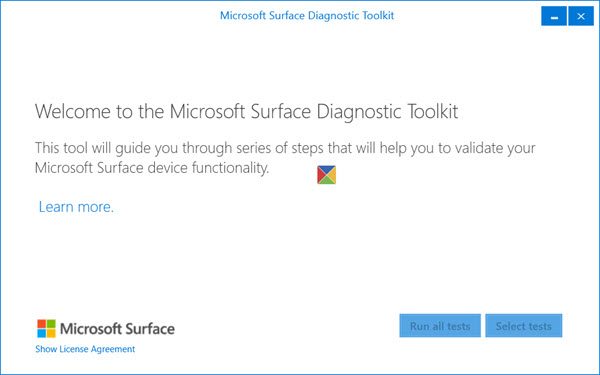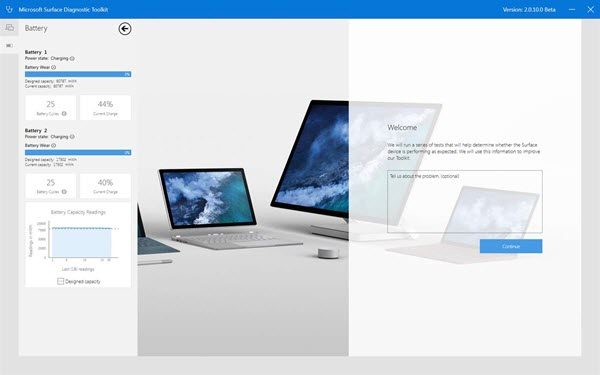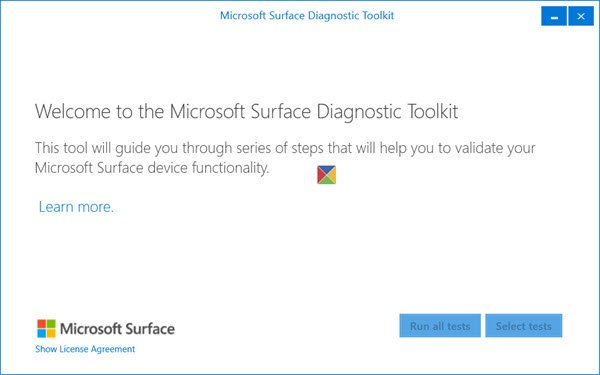Microsoft Surface devices have been known to be the perfect laptop replacements. If you are a Microsoft Surface device owner, then here is a great Diagnostic Toolkit to help you check the health of your device and run hardware diagnostics on Surface.
The Microsoft Surface Diagnostic Toolkit is a lightweight, portable diagnostic tool that runs through a suite of tests to diagnose the hardware of Surface devices. Weighing less than 3 MB, the tool does not require any installation and can run from a USB stick or over the network. Moreover, it runs a comprehensive series of tests covering all hardware aspects of your device to bring out any errors/issues that a user may not be aware of. It will work on Surface devices running Windows 11/10, Windows 1011/10 Pro, or Windows 11/10 S.

Microsoft Surface Diagnostic Toolkit
Running the Microsoft Surface Diagnostic Toolkit requires the user’s attention, and the diagnosis process is a hands-on activity. While running various test sequences, you would be prompted to respond with certain actions or observe the outcome of the test, and then click the applicable “Pass” or “Fail” button.
The Pre-requisites
Before starting with the tests, ensure that you have arranged the following,
- An external display with the appropriate HDMI or DisplayPort connection
- A Bluetooth device that can be put into pairing mode
- A MicroSD or SD card that is compatible with your Surface device
- A Surface Pen
- Room to move the Surface device around
- External speakers or headphones
All above Pre-requisites would be required to test various hardware components of your Surface device.
Hardware Tests performed by Surface Diagnostic Toolkit
Here is a look at the various hardware tests that are performed using the Microsoft Surface Diagnostic Toolkit. Users must note that not all tests apply to every device. Hence the selection of test should be done based on the device. Users can pick and choose individual tests suiting their devices, as mentioned below.
Windows Update
This test checks for the latest Windows updates, including drivers and firmware for the Surface device. You will be prompted to restart the device if required by Windows Update and then you need to restart the Microsoft Surface Diagnostic Toolkit again.
Device information
As the name suggests, this test brings out basic system information such as device model, operating system version, processor, memory, and storage. The Device ID is recorded in the name of the log file and can be used to identify a log file for a specific device.
Type Cover test
This test checks for the proper functioning of the keyboard and touchpad while Type Cover is on. The cursor should move while you swipe the touchpad, and the keyboard Windows key should bring up the Start menu or Start screen to successfully pass this test.
Integrated keyboard test
This test is similar to the Type Cover test with the only exception that here the integrated keyboard in the Surface Book base is tested rather than the Type Cover. Users must note that this test is only applicable to Surface Book and requires that the Surface Book be docked to the keyboard.
Battery Tests
Under Battery tests, there are four different tests, as mentioned below.
- Battery Health test: Checks for health and estimated runtime after the battery is discharged for a few seconds
- Canvas mode battery test: Applicable just for Surface Book, this test requires the device to be used in Canvas mode. Here, the screen is connected to the keyboard so that when the device is closed, the screen remains face-up and visible.
- Clipboard mode battery test: Applicable just for Surface Book, this test requires the device to be used in Clipboard mode. In clipboard mode, the Surface Book operates from an internal battery that is tested when the Surface Book is disconnected from the keyboard.
- Laptop mode battery test: Applicable just for Surface Book, this test requires the device to be used in Laptop mode. In laptop mode, the screen will face you when the device is open, and the device can be used in the same way as any other laptop.
Discrete graphics (dGPU) test
Applicable just for Surface Book models with a discrete graphics processor, this test is used to check the functioning of the cooling fan.
Muscle wire test
To disconnect the Surface Book from the keyboard, the software must instruct the muscle wire latch mechanism to open. This is typically accomplished by pressing and holding the undock key on the keyboard. This test sends the same signal to the latch, which unlocks the Surface Book from the Surface Book keyboard. This test is applicable just for Surface Book models.
Dead pixel and display artifacts tests
This test checks for malfunctioning pixels in your Surface device.
Digitizer Tests
The digitizer tests are further classified into different types are given below,
- Digitizer edges: This test is for checking the proper functioning of swipe starting from the edges of the device. In this test, a user swipes in from the left or right side of the screen. This test prompts you to swipe in from the edges of the screen to bring up the Action Center and Task View.
- Digitizer pinch: This test checks for the proper functioning of the pinch gesture (when you bring two fingers closer together or further apart). This test displays an image in Windows Picture Viewer and prompts you to zoom in, move, and zoom out of the picture. The picture should zoom in, move, and zoom out as the gestures are performed.
- Digitizer touch: The Surface touchscreen should detect input across the entire screen of the device equally.
- Digitizer pen test: This test requires a Microsoft Surface Pen and checks for the straight lines when the pen is pressed to the screen. The lines should remain unbroken for the test to pass.
- Digitizer multi-touch: This test is used to check the proper functioning of multi-touches. The user is required to place all fingers on the screen simultaneously to perform this test.
Home button test
Also called as Windows button test, this test checks if the Start screen or Start menu is displayed when the Windows button is pressed.
Volume rocker test
This is a volume test, and the volume slider should move up and down as the rocker is pressed.
Other tests
Microsoft Surface Diagnostic Toolkit performs a host of other tests apart from above. Some of them are given below.
- Micro SD test
- Microphone test
- Video out test
- Speaker test
- Bluetooth test
- Camera test
- Network test
- Power test
- Mobile broadband test
- Accelerometer test
- Gyrometer test
- Compass test
- Ambient light test
- Device orientation test
- Brightness test
- System assessment
- Performance Monitor test
- Crash dump collection.
The Microsoft Surface Diagnostic Toolkit can run from the command line or as part of a script.
To download the application, go here. It is also available as a part of the Surface Tools for IT. You may download the Surface Diagnostic Toolkit for Windows, SurfaceDiagnosticToolkit_SA.exe file, by clicking here. Run the tool and then follow the on-screen instructions.
Read: How to run System Diagnostics using System Information Tool?
Surface Diagnostic Toolkit available at Windows Store
If you are a Surface Laptop user, that runs the Windows S operating system, then you can download the Surface Diagnostic Toolkit from the Windows Store.

Part educator, part detective, and part doctor, the Surface Diagnostic Toolkit guides you through a set of software repairs and hardware diagnostics to quickly and efficiently uncover and resolve issues you are experiencing on your device. Use this app to check your battery health, lookup information about your device, repair common software issues, and validate your Surface hardware. The Surface Diagnostic Toolkit is the best place to start troubleshooting, and will guide you to the best support avenue for the quickest resolution, so you can get back to turning ideas into actions and accomplishing more with your Surface.
What does the Surface Diagnostic Toolkit do?
Surface Diagnostic Toolkit is a portable app that scans for possible hardware issues on your Surface device. It runs some tests on your device to detect whether your Surface device has some hardware problems or not. Following that, you can investigate and troubleshoot the issue recognized by this application.
How do I run a hardware diagnostic on my Surface?
It is pretty straightforward to run a hardware diagnostic on your Surface device. Instead of doing anything manually, you can make use of the Surface Diagnostic Toolkit. This portable program helps you run some tests and detect issues related to hardware.
Download links:
- Download it from the Windows Store.
- Download the Surface Diagnostic Toolkit for Windows
- Download the Surface Diagnostic Toolkit for Windows in S mode.
TIPS:
- Surface BitLocker Protector Check Tool verifies your BitLocker settings
- Use Surface Hub Hardware Diagnostic Tool to test device account.
